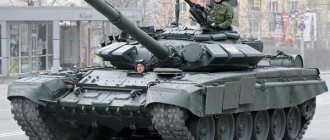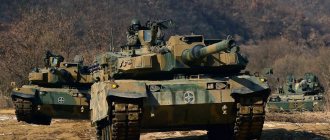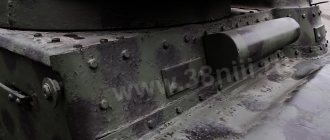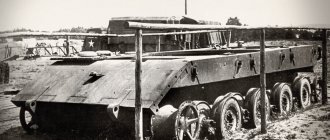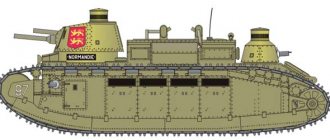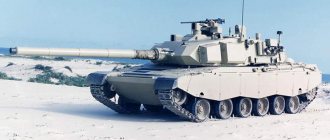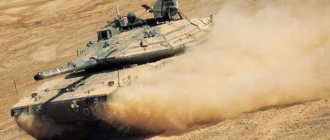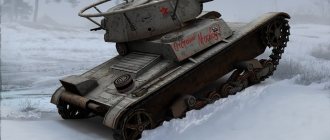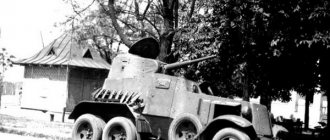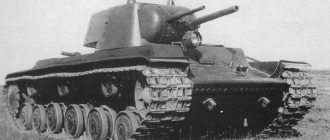Tank T-84U Oplot – video
The tank was developed by the Kharkov Mechanical Engineering Design Bureau named after. Morozov, based on the Soviet T-80UD tank.
The main designer of the machine is Dr. Tech. Sc., prof., lieutenant general. M. D. Borisyuk, general designer for the creation of armored vehicles and artillery systems, head of the KMDB CP.
Design
The tank has a classic layout, with the control compartment located in the frontal part, the fighting compartment in the middle and the engine compartment in the rear. Like the T-84, the Oplot BM used an automatic loader, which made it possible to have a crew of three people - a driver, a gunner and a commander. The driver is located in the center. The tank commander is located on the right, and the gunner on the left, each of them has a hatch for landing/disembarking.
The Oplot BM differs from previous KhKBM tanks (T-80UD, T-84) by improving the following characteristics:
Fire control
– new fire control system; – system for taking into account the bending of the barrel bore; – a combined panoramic commander’s sight with independent day and night (thermal imaging) channels, and a laser rangefinder;
Protection
– welded turret of a new shape made of rolled armor steel; – large side screens that provide additional protection for the sides of the hull and chassis from hand-held anti-tank grenade launchers; – built-in DZ “Duplet” (outwardly reminiscent of “Knife-2”), providing better protection against armor-piercing shells and tandem cumulative ammunition; – “Varta” complex;
Mobility
– a new integrated tank control system that provides automatic gear shifting and smooth turning while driving; – 6TD-2E engine with a power of 1200 hp. With. with reduced smoke and toxicity of the exhaust; – diesel auxiliary power unit with a power of 10 kW; – new on-board computer for the driver, new radio communications.
Firepower
The main armament of the tank is the 125-mm KBAZ smoothbore gun, which is a copy with minor modifications of the 2A46M-1 gun designed in 1970, which has a barrel length of 48 calibers and is equipped with a conveyor-type automatic loader. The gun is equipped with a powder gas ejector, a thermal casing and is stabilized in two planes.
The gun barrel is quick-detachable and can be replaced in the field without removing the turret from the tank. The turret rotation drive is electric, the gun drive is hydraulic. The turret rotates 180 degrees in less than 5 seconds (the rotation speed of the turret relative to the hull is up to 40 degrees/sec). In case of an emergency, backup mechanical drives for pointing the gun and turret are provided.
The gun's ammunition capacity is 46 rounds of separate cartridge loading, of which 28 are placed in the automatic loader. The Oplot BM is capable of firing armor-piercing sub-caliber, cumulative, high-explosive fragmentation shells and Kombat ATGMs with a semi-active laser beam control system.
The tank's rate of fire is up to 8 rounds/min. (7-12.5 seconds for loading one shot), which is achieved due to the automatic loader and tandem loading (projectile-charge) in one cycle. Removal of the spent pallet is carried out by automatically catching it and placing it in an empty tray without depressurizing the fighting compartment. The loading time of the automatic shot loader conveyor is 15-20 minutes. There are also redundant drives for the automatic loader conveyor and a manual loading mechanism.
Guided weapons
A distinctive feature of the tank is the presence of a KWV (guided weapons complex), which allows firing from a cannon with laser-guided Kombat guided missiles (ATGMs) at distances of up to 5 km and provides armor penetration behind dynamic protection of at least 750 mm. ATGMs are placed in the automatic loader in the same way as conventional shells.
The Kombat ATGM is conducted above the line of sight almost throughout the entire flight, and its transfer directly to the target is carried out automatically just 0.3 seconds before the moment of destruction. This solution compares favorably with laser illumination of the target throughout the entire flight of the missile in that the enemy cannot interfere with the ATGM relying only on laser irradiation sensors.
Firing of the Combat ATGM is possible at tank speeds of up to 30 km/h, at targets moving at speeds of up to 70 km/h.
Auxiliary weapons
The tank is equipped with auxiliary weapons:
– anti-aircraft machine gun KT-12.7 mm (ammunition 3 × 150 rounds) with a remote control system; The vertical guidance angle ranges from −3° to +60°, the heading angle is in the range of ±75°; the machine gun is vertically stabilized in the range from −3° to +20°; – a KT-7.62 mm machine gun coaxial with a cannon (1250 rounds of ammunition).
Fire control system and sighting devices
The fire control system (FCS) of the Oplot BM provides round-the-clock and all-weather aiming and firing from a cannon, coaxial and anti-aircraft machine guns, including by the tank commander. The tank's control system includes:
sighting system: – the gunner's day sight "Promin" 1G46M is equipped with independent stabilization in two planes, a laser rangefinder (up to 9990 m with an accuracy of ±10 m) and a semi-active control channel for the "Kombat" ATGM. Has a magnification of 2.7-12x. – thermal imaging sighting system for gunner PTT-2. Designed to detect ground and air targets, and targeted shooting at them day and night. Target detection range is up to 8000 m, recognition range is 4500 m and identification range is 2500 m. – PNK-6 commander’s panoramic sighting system. Designed to detect ground and air targets from the commander's position, and targeted shooting at them day and night. Equipped with a laser rangefinder. The detection range of tank-type targets is 5500-8000 m. – 2E42M weapon stabilizer – SUIT (barrel bending accounting system) increases shooting accuracy due to automatic correction of aiming angles and lateral lead generated by the ballistic computer, taking into account the thermal bending of the barrel from solar radiation and its own warming up during intense shooting. – remote control system for anti-aircraft machine gun 1ETs29M
Design
The Oplot was designed and created at the Kharkov Design Bureau named after Morozov.
Externally, the T-84U bears a strong resemblance to its Soviet predecessors. USSR-era MBTs were famous for their low silhouettes and Oplot was no exception. The chassis on each side consists of a drive wheel at the rear, six rubber-coated road wheels and guides at the front. The driver is located in front, behind a strongly inclined frontal plate. The hexagonal turret is located in the middle of the hull, has inclined frontal plates and a cannon protruding far beyond the hull. On the sides of the roof there are hatches and a large-caliber machine gun, which can be used by the commander against infantry or air targets while the main gun is used against armored targets. There is also a coaxial machine gun controlled by a gunner. Traditionally, Soviet tanks use an automatic loader, thanks to which the crew consists of 3 people - a commander, a gunner and a driver. There is a modern KNIFE and a self-entrenching system.
Security and survivability
Ballistic protection
The Oplot BM has a combined protection system that includes passive armor, built-in dynamic protection and a number of other protection systems that increase the survivability of the tank on the battlefield. The armor is multi-layered, consisting of armor plates and ceramic materials. The roof of the tower is made entirely stamped, which increases its rigidity and ensures good manufacturability and stable quality in mass production.
On the front part of the hull, turret and sides of the tank, a new-generation “Duplet” built-in ERA (dynamic protection) is installed, which provides protection against cumulative and armor-piercing sub-caliber ammunition. The modular design allows for quick replacement of protection elements during upgrades or damage. Wide rubber screens are installed on the sides of the Oplot BM hull, providing additional protection against hand-held anti-tank weapons such as RPG-7. Elements of the “Duplet” remote sensing system do not detonate when hit by 12.7 mm caliber bullets, armor-piercing shells up to 30 mm caliber and shell fragments. In this case, the detonation of dynamic protection occurs from the close rupture of a 125 mm high-explosive fragmentation projectile.
The operating principle of dynamic protection is based on the initialization of multiple cumulative jets with the aim of cutting the attacking ammunition into pieces. The defense can also destroy tandem ammunition by cutting the main charge if the angle of impact is favorable. However, such a design makes it impossible to protect against tandem ammunition with a large charge spread along the length, and also tends to undermine adjacent protection modules.
DZ "Duplet" does not require maintenance and is safe to use. Installation of this EPS is possible by the crew without special tools in 2.5-3 hours. Dynamic protection modules cannot be repaired in the field.
According to the tank manufacturer, Oplot-M VPTDZ (built-in anti-tandem dynamic protection) provides protection from:
– anti-tank hand and easel grenade launchers, and recoilless rifles; – anti-tank missiles such as “TOU-2”, “Milan”, “Sturm-S”; – cumulative shells of smoothbore tank guns of 125 mm caliber (3БК18М, 3БК18, 3БК14М, 3БК14); – armor-piercing sub-caliber projectiles for smooth-bore tank guns of 125 mm caliber (3BM22, 3BM26, 3BM42) and 120 mm tracer finned sub-caliber projectile with a detachable Cl3069 pan.
Dynamic protection reduces the penetration of an armor-piercing sabot projectile by 25%, the effectiveness of ATGMs is reduced by 60%, and the effectiveness of cumulative projectiles by 40%.
Mine protection ensures crew survival when mines with a TNT equivalent of 10 kg are detonated under the caterpillar, and up to 4 kg under the bottom (in the front compartment).
The tank is equipped with an automatic fire extinguishing system in the crew compartment and logistics. The Oplot-M is also equipped with a PRHR-M1 (radiation and chemical reconnaissance device) and a system for protection against weapons of mass destruction.
Active protection
The active protection of the Oplot BM involves the use of the Varta KOEP (optical-electronic countermeasures complex) for setting up screens and active protection for the destruction of Zaslon ammunition.
"Varta" is capable of detecting laser targeting on a tank and laying a smoke screen. An obvious disadvantage of the complex is its inability to respond to the flight of attacking ammunition due to the lack of a radar. Modern laser-guided ATGMs like the Kornet or Skif, and even the Kombat ATGM itself, which is equipped with the tank, direct the laser beam above the target for most of the missile’s flight and lower the laser onto the target 0.3 seconds before it is hit when actually guidance is completed and the installation of the curtain is of limited effectiveness. Varta is not intended for installing aerosol curtains that are opaque in the infrared range, since the complex does not have means of detecting ATGM missiles with an infrared seeker. However, the complex is useful for responding to laser rangefinders of artillery systems and against a number of ATGMs.
Active protection “Zaslon” with fairly advanced characteristics has been developed for the tank. The defense consists of modules, each of which is equipped with its own mini-radar with a range of 2-3 meters and a non-firing grenade to destroy attacking ammunition. Instead of shooting a grenade, as in other KAZs, a cylinder with a grenade and a mini-radar is extended by an electric motor. The attacking ammunition is detonated 0.5-1 meters from the tank. This design makes it quite easy to implement protection of the upper hemisphere and organize full or partial protection of the tank. Also, the absence of the need to calculate the trajectory of protective ammunition allows one to achieve high performance, sufficient even to destroy not only missiles, but also armor-piercing sub-caliber projectiles. True, the developers were only able to demonstrate the interception ability of the 3BM22 “Karolka”, designed in 1976, whose speed is approximately 2 times lower in the final segment of the trajectory than that of modern BOPS. However, the ability to respond to sub-caliber armor-piercing projectiles is quite unique for active protection systems.
A significant aspect is the rather high cost of the Zaslon, since the complex requires at least 16 mini-radars instead of one radar, so at the moment mass production is only planned[24]. Experts also put forward the theory that the Zaslon did not go into mass production due to the fact that inserting the complex into the armor could disrupt the rigidity of the reservation, and the released KAZ cylinders could be lost when maneuvering off-road.
Engine
The tank is equipped with a six-cylinder diesel engine 6TD-2E with a volume of 16.3 liters and a power of 1200 hp. The engine is a two-stroke, multi-fuel (runs on gasoline, kerosene, diesel fuel or a mixture of them in any proportion), with supercharging, direct-flow blowing, direct fuel injection, with horizontal cylinders and counter-moving pistons. Due to the low engine height (581 mm), the engine compartment is designed in a two-story design. An ejector radiator cooling system is installed above the engine.
Compared to the 6TD, the previous engine version, the specific power increased by 20%, reaching 73.6 hp. s./liter with the same dimensions (L x W x H, mm: 1602 x 955 x 581) and weight (1180 kg)[28]. Due to the compactness of the engine and the peculiarities of its design, the power plant is located transversely in the MTO (engine-transmission compartment) of the tank and coaxially with the onboard gearboxes. Thanks to this, engine alignment is not required when replacing it, the tank transmission is significantly simplified and ensures small dimensions of the MTO (3.1 m³).
The engine has been upgraded to increase efficiency and reliability in different climates and weather conditions. The design and features of the engine ensure its operation at air temperatures up to +55 °C with virtually no reduction in power, while, for example, the power of the four-stroke diesel engine B-92S2 of the T-90 tank drops from 1000 to 600 hp. With. at air temperature +55 °C.
As noted above, the 6TD-2E engine is multi-fuel and is capable of running on diesel fuel, jet fuel (kerosene), gasoline and mixtures thereof. The capacity of the internal fuel tanks is 575 liters, the external tanks located on the fenders are 570 liters. To increase the power reserve, two additional fuel barrels with a volume of 380 l (2 x 190 l) can be installed at the rear of the hull.
Fuel consumption per 100 km on a dry dirt road is 325-370 liters, on a hard-surface road - no more than 300 liters. The fuel system of the tank supplies the engine with fuel both from each group of tanks separately, and from both groups simultaneously.
The engine air intake ensures air flow from the least dusty point of the tank and allows you to overcome water obstacles up to 1.8 m deep without preparation.
Auxiliary power unit
The tank is equipped with a 10 kW diesel auxiliary power unit. The APU is designed to provide electricity to a tank with the engine turned off, for example, when the tank is in a stationary firing position or in an ambush. It is installed on the right fender in a sealed armored compartment, and is connected to the electrical and fuel systems of the main engine.
Transmission
The planetary gearbox with automatic gear shifting has 7 forward and 4 reverse gears. The maximum speed is 70 km/h forward and 35 km/h in reverse.
The new integrated tank motion control system ensures smooth turning both while moving and at a standstill, and also improves the dynamic acceleration characteristics of the tank by ensuring optimal gear shifting. This tank control system allows smooth turns using the steering wheel instead of levers, which greatly simplifies the control process, reduces driver fatigue, increases maneuverability and allows for duplicate control. This system has high efficiency and was developed by KMDB. A similar control system as part of the Kharkov MTO with a 6TD-2 engine is exported abroad for installation on Pakistani Al-Khalid tanks and Chinese MBT 2000.
Chassis
The chassis of the Oplot BM on each side consists of six double rubber-coated road wheels with a diameter of 670 mm, five support rollers with a diameter of 225 mm, a idler and a drive wheel located in the stern. The suspension of the road wheels is individual, torsion bar, with six hydraulic telescopic shock absorbers (on the first, second and sixth suspension units). The suspension units are moved out of the armored body to free up space in the latter and facilitate suspension maintenance.
The tank can be equipped with two types of tracks: an asphalt track width of 580 mm, which ensures high speed of the tank on an asphalt concrete road, and a width of 600 mm with increased lugs for movement on ice and loose soil. At the bottom of the bow of the hull there are rubber skirts, designed to reduce dust while driving.
Surveillance, communication and navigation equipment
The tank is equipped
surveillance means: – optical daytime observation devices TNPO-160 and TNP-165A; – driver’s night vision device TVN-5;
means of communication: – VHF radio station R-030U, providing a communication range in moderately rough terrain of up to 20-25 km; – commander’s HF radio station R-163-50K, providing a communication range of up to 250-350 km; – internal communication and switching equipment AVSK-1 (R-174); – noise-absorbing headsets ShSh-1;
navigation means: – TIUS-NM satellite navigation system, consisting of radio navigation equipment for satellite navigation SN-3700-03 (provides continuous determination of the tank’s coordinates using radio signals from the GLONASS and GPS NAVSTAR systems at any point in the world, time and weather conditions); the root-mean-square error in determining the coordinates of the tank's location is 40 m using NAVSTAR GPS signals, 30 m using GLONASS and 20 m when using both navigation systems simultaneously; The tank's navigation system is capable of storing up to 10 routes with 50 control points for each of them;
commander's information console 1KPI-M, designed for entering initial settings, codes, commands, requests, coordinates of destinations and waypoints into the computer, as well as displaying on the screen the entered information and data received through a radio station or navigation system; information about the location of the tank and other armored vehicles of your unit on the battlefield, destinations and waypoints are displayed on the screen in text or graphic form.
Ergonomics
The ergonomics of the tank are ensured by the following components:
– automatic gear shifting, which greatly simplifies control, reduces the driver’s training time and fatigue during long-term driving of the tank; – a digital panel (on-board computer) of the driver, designed to indicate fuel and oil levels, control the operation of the heater, pre-start preparation and start of the main engine, turn lights on and off, display engine and transmission parameters; – an air conditioning system, consisting of two air conditioners installed in the hull and turret, and providing comfortable working conditions for the crew by cooling, drying or heating the air in the habitable compartment.
Production
Production of the first tank began at the end of 2008 and took three months. In May 2009, the tank was adopted by the Ukrainian Armed Forces under the name BM “Oplot” and a contract was signed for the supply of 10 units at a price of 29.5 million hryvnia. Due to lack of funding, production was suspended. On February 20-24, 2011, "Oplot" was shown abroad for the first time - at the 10th International Arms Exhibition IDEX-2011 in Abu Dhabi. The export price of one tank in 2011 was $4.9 million, in 2013 - $4.89 million. Serial production began in 2013. In December 2011, Deputy General Director of the Ukroboronprom State Concern Vladimir Kuratchenko said that 40 Ukrainian enterprises were involved in the production of the tank. Serial production of Oplot tanks began in 2013, but the first PNK-6 sights were manufactured in January 2014.
Representatives of the Ukrainian military-industrial complex made many statements about various plans for the mass production of Oplot, but all of them were thwarted. So on February 4, 2015, the General Director of the Ukroboronprom State Corporation R. A. Romanov announced that 40 Oplot tanks would be produced in 2015. On December 25, 2015, the Cabinet of Ministers of Ukraine adopted a resolution to provide the plant with. Malyshev state guarantees in order to ensure the plant’s implementation of the previously approved program for the production of Oplot tanks. In 2015, the production of tanks was completely disrupted and not a single copy was produced either for the needs of the Armed Forces of Ukraine or under contractual obligations.
Deliveries to Thailand
On September 1, 2011, a contract was signed for the sale of Oplot-M to foreign buyers - Ukrspetsexport State Corporation and Thailand signed a contract worth $241 million for the production and supply of 49 tanks. In the modification for the Thai army, in comparison with the standard version, Some changes were made to the internal equipment, communication equipment and headsets, air conditioning was installed for comfortable work of tank crews in tropical climates.
On June 26, 2013, the first manufactured tank was presented. On November 5, 2013, the first batch of 5 tanks was handed over to representatives of the Thai army in Kharkov. In December 2015, it became known that since not a single Oplot was produced in 2015, the Government of Ukraine requested a transfer of the contract to 2016. According to Interfax Ukraine, in May 2016, Ukraine supplied the third batch of new Oplot tanks consisting of 10 vehicles to Thailand. Thus, the total number of Oplot tanks in the Thai army was increased to 20 units. The next batch of Oplot tanks, numbering five vehicles, arrived in Thailand in mid-November 2016.
In January 2022, data appeared about the termination of the contract, but Ukrspetsexport announced the existence of an agreement to reschedule deliveries. Acceptance of another five takes place in mid-January (“It is expected that the remaining 19 tanks will be delivered before the end of this year”).
Machine evaluation
M. D. Borisyuk, general designer for the creation of armored vehicles and artillery systems, head of the KMDB KP, lieutenant general, doctor of technical sciences, professor:
– “Oplot” is a fundamentally new vehicle, which was created at the level of modern world analogues... In terms of its main characteristics - combat power, mobility and protection - the "Oplot" tank is at the level of the best world models... "Oplot" today has the highest level of protection in the world among its analogues, in particular from tandem-type ammunition.
In the book “The Armor is Strong,” M. D. Borisyuk outlines the directions for improving the tank:
– For the Oplot tank, first of all, it is necessary to improve the characteristics of weapons and ammunition, including strengthening the barrel bore. In general, the problem of ammunition is becoming more and more acute, and this problem, due to its capacity and high level of expenses, is within the competence of the Ukrainian government. It cannot be defeated without a decision at the highest level. Further on the Oplot tank, the tank’s protection from the upper hemisphere should be increased and optimized, especially from enemy helicopter fire. Finally, the third important area should be to increase the engine power reserve by approximately 200 horsepower, without increasing the overall dimensions of the engine and transmission compartment.
According to Vasily Chobitka, author of the Armor Site, Oplot-M is a good candidate for replacing the T-64, T-72, T-80 tanks and subsequent unification of the tank fleet.
pros
– The engine of the 6TD-2E tank has been tested in production, is reliable and well suited for operation in hot and high-altitude climates, where potential customers for the export version of the tank are located.
– High specific indicators of liter and overall power of the 6TD-2E engine (the specific power of the Oplot-M engine-transmission compartment is 387 hp/m³ versus 333 and 258 hp/m³, respectively, for the Leopard 2 and "Abrams"), due to which the required volume of logistics is reduced, the silhouette and weight of the tank are reduced.
– Less power loss when using an ejector cooling system for engine radiators compared to a fan system. A four-stroke diesel engine, for example, the V-92S2, spends up to 15% of the torque on driving the radiator cooling fan in intense operating conditions, while the 6TD-2E ejector cooling system works much more efficiently, quickly responds to changes in ambient temperature, is simpler in design and has no moving parts.
– A modern automatic transmission provides maneuverability and ease of control at the level of the best Western tanks.
– The ability to cross water obstacles up to 5 meters deep, while, for example, the equipment for crossing water obstacles of the M1 Abrams tank allows you to overcome water obstacles no more than 2 meters deep.
– Uniform tower protection and a small number of weakened zones.
– Made from high-strength armor steels with electroslag remelting, which provides an increase in resistance to penetration, all other things being equal, by 10-15%.
– Modern modular anti-tandem dynamic protection of the turret and hull “Duplet” with declared characteristics of up to 90% reflection of cumulative ammunition.
– Active protection systems “Varta” and “Zaslon” designed to protect the upper hemisphere and even destroy sub-caliber projectiles.
– The use of an ejector cooling system and the engine exhaust back, compared to the exhaust on the left or right side, helps to slightly reduce the visibility of the tank in the infrared range, which makes it difficult to target detection and destruction weapons with infrared homing heads and is critical for the survival of the tank on the battlefield. It should be taken into account that this tool is useless against modern ATGMs such as the Javelin or the Russian Hermes, which use the “signature” method for targeting the tank, and it is enough for the ATGM to have only characteristically heated areas for targeting.
– The Kombat guided weapon system allows you to hit targets at a distance of up to 5.0 km. At ranges over 2.5-3.0 km, ATGMs have advantages over BOPS in terms of hit accuracy and armor penetration.
– The presence of an automatic loader increases the real rate of fire on the battlefield and eliminates the human factor (fatigue of the loader, the difficulty of manual loading when driving fast over very rough terrain).
Minuses
– The 6TD-2E engine requires the installation of a large, highly efficient air-purifying system, which is due to the characteristics of the tank’s two-stroke engine (a significant amount of air is used to purge the cylinders, which increases the total air consumption). Pictogram voting opposed.svg High oil consumption (7-19 l/100 km on a dry dirt road and 4-11 l/100 km on a hard-surface road) and incomplete combustion of the working mixture create a very smoky and toxic exhaust.
– To start the engine, it is necessary to use electric torch heating and oil injection systems at ambient temperatures below +5 °C (below −25 °C when using low-viscosity oil).
– Lack of active suspension, which leads to a decrease in the speed of the tank over rough terrain and a significant drop in shooting accuracy in off-road conditions.
– There is no system for automatic delivery of multispectral curtains that are opaque in the infrared and radio ranges, but only smoke screens (transparent in the IR range), which is critical against modern ATGMs with seekers in the infrared and radio ranges.
– Insufficient protection of crew members from the detonation of ammunition in the event of penetration of the armor (the ammunition is only partially removed from the fighting compartment, there are no ejection panels on the turret, there is no “wet” ammunition stowage or placement of shells in protected individual containers, such as, for example, on the Challenger 2 tanks " and "Merkava"). There are no armored crew capsules or armored curtains to minimize crew losses in the event of armor penetration.
– Lack of stealth technologies such as a special coating to block infrared radiation through armor, lack of stealth technologies to reduce radio signature. Lack of technologies for “dynamic distortion of the signature” of a tank to block ATGMs, working on the principle of capturing a tank’s signature to distinguish it from traps and interference.
– Lack of means of protection against magnetic mines and high-precision ammunition with magnetometric sensors that attack a tank in the roof of the TOW-2B type by distorting the magnetic field of the tank.
– Lack of electronic warfare equipment to destroy ATGMs with their own guidance radars such as JAGM, radio command guidance such as Chrysanthemum and ATGMs with wire control like Fagot with an electromagnetic pulse.
– External fuel tanks are not armored or protected from cumulative ammunition, so a tank with external fuel tanks can catch fire even from small arms.
– The fire control system is outdated and significantly inferior to the latest analogues, for example, the control system of the Japanese Type 10 tank. The control system of the BM “Oplot”, in particular, does not provide automatic tracking of a moving target taken into the sights, taking into account corrections for its defeat.
– There is no full-fledged automated TIUS (tank information and control system) that would combine all the electronic systems of the tank into a single network.
– There is no BIUS (combat information and control system), which provides automated control of the tactical unit and allows the exchange of combat and intelligence information on the battlefield between the tank, other military equipment of various types of troops and control points in real time.
– Fire damage is not enough to penetrate the armor of next generation tanks with armor equivalent of more than 1000 mm.
Criticism
The very long production cycle of the Oplot is also becoming a target of criticism. So, in three years, Thailand received five tanks out of 49; As of November 2016, only 25 vehicles were delivered to Thailand.
Criticism from the Administration of the President of Ukraine
According to Advisor to the President of Ukraine Yuriy Biryukov, it is more profitable to orient the production of Oplot for export, and to use the proceeds to upgrade the Soviet-made T-64 to Bulat, since the real conditions of combat operations by the Armed Forces of Ukraine do not allow using the advantages of Oplot. Yuri Biryukov, analyzing the estimates of Ukroboronprom, points out that it is significantly more profitable to repair and modernize several old Soviet T-64s for the same money. Biryukov is supported by the former director of the Plant named after. Malyshev Nikolai Belov, who points out that the Soviet T-64 has the same gun and dynamic protection elements. At the same time, the technology of repair and restoration work makes it possible to carry out a major overhaul of the Soviet T-64 in a few months, while at the same time, the technological cycle for the production of one “Oplot” is at least 9 months.
Scimitar
The T-84-120 Yatagan appeared as an export option and took part in the Turkish tender. It has a 120 mm turret standardized for Western ammunition, a rear niche for storing ammunition and a modified automatic loader. The Yatagan also uses foreign components.
In addition to Turkey, Thailand became interested in the Ukrainian vehicle, choosing between the Oplot, Black Panther, T-90 and Leopard-2 tanks. On November 5, 2013, the first 5 tanks were delivered.
Tactical and technical characteristics of the T-84U Oplot
Crew, people: 3 Layout: classic Number of produced, pcs.: 10
Weight of T-84U Oplot
– 51 tons
Dimensions of T-84U Oplot
– Hull length, mm: 7705 – Length with gun forward, mm: 9664 – Hull width, mm: 3775 – Height, mm: 2760 – Ground clearance, mm: 515
Armor T-84U Oplot
– Active protection: “Varta” – Dynamic protection: built-in, “Knife”
Armament of T-84U Oplot
– Caliber and brand of gun: 125 mm KBA-3 – Gun type: smoothbore – Barrel length, calibers: 48 – Gun ammunition: 40 rounds – Sights: 1G46-M; PTT-2; PNK-6 – Machine guns: 12.7 mm anti-aircraft machine gun KT-12.7; 7.62-mm machine gun KT-7.62 – Other weapons: PM; AKSU-74; SPS; grenades
Engine T-84U Oplot
– Engine type: 6TD-2 – Engine power, l. pp.: 1200
Speed T-84U Oplot
– Highway speed, km/h: 65–70 – Cross-country speed, km/h: 45–50
– Cruising range on the highway, km: 450 – Cruising range over rough terrain, km: 350 – Suspension type: individual torsion bar – Specific ground pressure, kg/cm²: 0.93 – Climbing grade, degrees: 32 – Climbing wall, m: 1.0 – Overcoming ditch, m: 2.85 – Overcoming ford, m: 1.8
What tanks are in service with Ukraine?
The Armed Forces of Ukraine (AFU) inherited from the USSR a colossal amount of armored vehicles that were in service with the Kyiv, Carpathian and Odessa military districts. In terms of the size of the tank fleet in 1992 (about 7 thousand units), Ukraine in Europe was second only to Russia and quite a bit to Germany. The basis of the Ukrainian tank forces was made up of very modern T-64, T-72 and T-80 tanks in fairly modern modifications at that time.
Ukraine's surplus tank fleet was widely sold around the world, and the burden of maintaining its own tank units was steadily reduced due to their periodic reductions. By 2014, the country had about 700 tanks in the armed forces (many of them were not combat-ready) and about 1,450 vehicles at storage bases.
For the purpose of unification, the T-64 is recognized as the main tank of the Ukrainian Armed Forces, and not only due to its quantitative dominance. “Sixty-fours” in various modifications and their “direct successors” T-80, as well as their engines, were produced in Kharkov, tank guns - in Sumy. Tanks of the T-72 family were not assembled at the Kharkov plant; initially there were a relatively small number of them.
T-64BM "Bulat" of the Ukrainian Armed Forces, shot down near Lugansk airport
After the events of 2014 and active hostilities in the Donbass region, the Ukrainian side irretrievably lost at least 230 tanks. Many of the remaining vehicles were seriously damaged or found to be severely worn out. To compensate for losses, the command of the Armed Forces of Ukraine had to carry out large-scale seizures of armored vehicles from storage bases, a significant part of which was already actually scrap metal.
As a result, to date, the Armed Forces of Ukraine have 680 tanks, according to the standard equipment of their units, although a significant part of them are still in a non-combat condition. The machine types are distributed as follows:
- 475 tanks T-64B, T-64BV, T-64BM;
- 143 tanks T-72AV, T-72B1;
- 62 tanks T-80BV, T-80UD.
The combat capabilities of all Ukrainian tanks are considered quite high. Restoration, repair and replenishment of the current tank fleet of Ukraine in relation to the T-64 is carried out according to the standards of the so-called “modernization of the 2022 model”, within which the tanks, in their parameters, represent a version of the T-64BV with newer thermal imagers, digital radio stations, and satellite navigation equipment and dynamic protection modules. According to Ukroboronprom, such modernization of equipment has so far been carried out for more than 150 tanks, and from the beginning of 2022, similar systems began to be installed on T-80 tanks.
Differences from its predecessor
Despite the fact that Oplot is a tank produced on the basis of the T-80UD, it has many features that distinguish it from its predecessor. Here is their complete list:
- New armor manufactured using the welded-rolled type.
- Built-in dynamic protection, which significantly improves the survivability of the tank on the battlefield.
- New sights.
- The Ukrainian Oplot tank received an engine with a capacity of 1200 horsepower, in contrast to the 1000 horsepower power unit of its predecessor.
- Transition to a digital OMS.
- An optical-digital countermeasures complex has been installed.
- Additional power supplies.
- A system that takes into account the degree of trunk bending.
- Modern navigation systems.
- New, wide side screens, significantly increasing the degree of protection of the tank from the main anti-tank weapons that are used today.
An electric drive was used for the turret, and a hydraulic drive for the gun. The tower rotates 180 degrees in just five seconds. In case of combat damage, manual drives for turret rotation and gun rotation are provided. Since the first model of the Oplot tank was presented to the public back in 1999, some of the new technical solutions were introduced relatively recently; some elements may not be present on older vehicles.
Story
Work on the production of the first tank started at the end of 2008 and lasted three months.
In the spring of 2009, the Ukrainian Armed Forces accepted the tank into service, which was given the name BM "Oplot".
In the same year, an agreement was signed for the supply of 10 units of the Oplot combat vehicle to the Ukrainian Armed Forces. But due to insufficient funding, delivery was suspended.
In February 2011, the tank was demonstrated in Abu Dhabi, at the International Arms Exhibition IDEX-2011.
At the end of the same year, it was announced that 40 Ukrainian enterprises were taking part in the production of the Oplot BM.
Mass production of Oplot began in 2013, but PNK-6 sights began to be produced only at the beginning of 2014.
At the same time, official information appeared that 40 tanks would be produced in 2015.
Anti-tank defense systems
The passive armor system is very important for protection, which is a kind of “pie” consisting of alternating sheets of armored steel and ceramics, which allows not only to confidently counteract the cumulative shots of modern grenade launchers, but also prevents the armor from spalling even when it is pierced. Based on this, the Ukrainian media call this vehicle nothing less than “the best tank in the world.” "Oplot" is evidence that even modern Ukrainian industry is capable of producing excellent armored vehicles.
The “Knife” system is mounted on the front of the tank, which, unlike its domestic counterparts, provides protection not only from cumulative, but also from sub-caliber armor-piercing shells.
In general, the Oplot tank, the characteristics of which we are now considering, is theoretically one of the most protected vehicles in its class. “Theoretically” - because there is no data on its combat use. In any case, these vehicles do not seem to be involved in the well-known events in the South-East of Ukraine.

